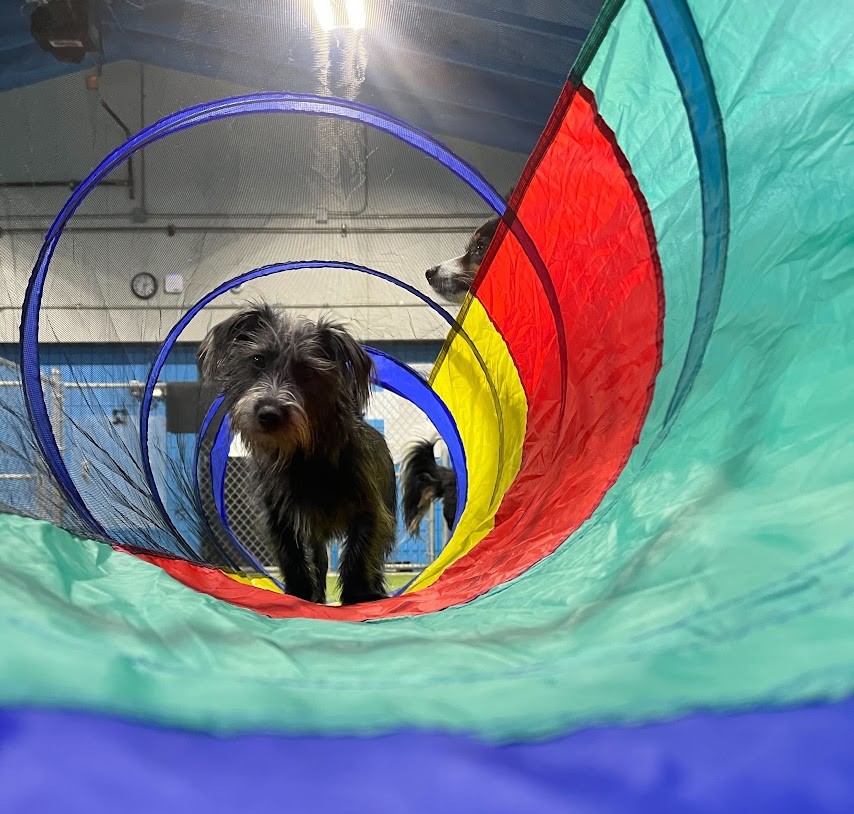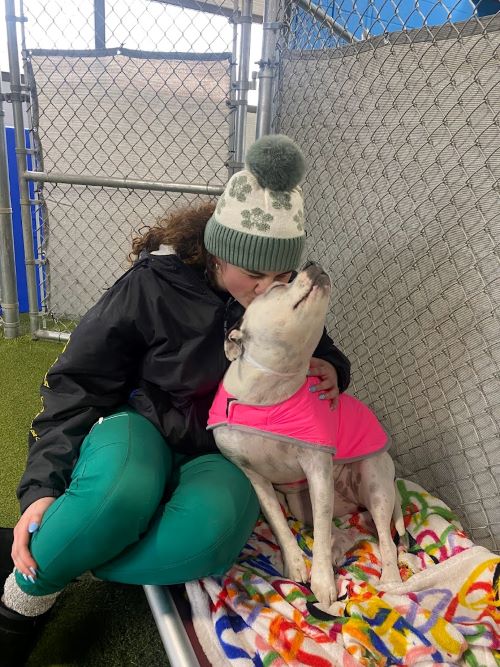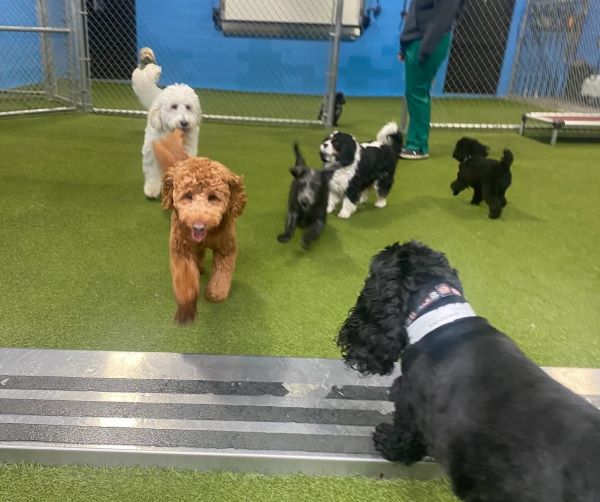Frosty Fun and Furry Friends: The Winter Magic of Doggie Daycare
When frigid winter temperatures and several inches of snow roll in, the question of how dogs stay active and social is more difficult to answer. Here at Cascade Hospital for Animals, petcare supervisor Tiffany Wilson provides all of the answers!
In this blog, Tiffany shares insights into the measures taken by our doggie daycare, The Crate Escape, to ensure dogs not only stay warm but also engage in exercise and socialization during the colder months.
How do you ensure the safety and well-being of dogs during winter at the daycare?
Throughout the year, a key p riority is maintaining a clean yard free of debris. This includes tasks such as raking leaves during the fall and shoveling snow in the winter. These efforts are essential to prevent pets from slipping as they play in the yard. Shoveling snow also prevents dogs' feet from accumulating small snowballs in their fur, ensuring their pads stay warmer and drier during outdoor activities. The overall goal is to provide a safe and comfortable environment for our furry friends in every season.
riority is maintaining a clean yard free of debris. This includes tasks such as raking leaves during the fall and shoveling snow in the winter. These efforts are essential to prevent pets from slipping as they play in the yard. Shoveling snow also prevents dogs' feet from accumulating small snowballs in their fur, ensuring their pads stay warmer and drier during outdoor activities. The overall goal is to provide a safe and comfortable environment for our furry friends in every season.
Can you describe the specific protocols in place for outdoor play in cold weather?
Ensuring the yards are consistently cleared of snow is a priority for us. We closely monitor the temperature, deciding whether it's suitable for outdoor play based on whether it's above or below freezing, at our discretion. In extremely cold conditions, we keep the outside doors closed, confining play to the indoor area. Recognizing that larger dogs handle the cold better than smaller ones, we adjust play areas accordingly. For instance, the small area may be indoor only, while the large area remains open for dogs to choose between indoor and outdoor play. If doors are open on colder days, we periodically call dogs inside to warm up before returning outdoors.
Dogs are perceptive and often decide to come inside on their own if it's too cold for them. Additionally, we implement breaks between play sessions, with each group having three sessions alternating by the hour. This approach proves beneficial year-round, preventing boredom by providing stimulation through breaks. The breaks also assist in regulating the dogs' body temperature, ensuring they stay comfortable and engaged during play.
What measures do you take to keep the indoor areas comfortable and engaging for dogs during winter?
 Our indoor spaces are heated so the play can move indoors when necessary due to cold weather. Cots are strategically placed around the indoor areas, providing comfortable lounging spots for dogs. Interestingly, small dogs often turn these cots into impromptu play areas, resembling a jungle gym. Blankets are also provided for the small dogs, adding an extra layer of comfort. The play equipment is versatile and movable, allowing us to bring some indoors during cold weather. However, dogs usually find joy in each other's company, and the cots prove to be more than sufficient.
Our indoor spaces are heated so the play can move indoors when necessary due to cold weather. Cots are strategically placed around the indoor areas, providing comfortable lounging spots for dogs. Interestingly, small dogs often turn these cots into impromptu play areas, resembling a jungle gym. Blankets are also provided for the small dogs, adding an extra layer of comfort. The play equipment is versatile and movable, allowing us to bring some indoors during cold weather. However, dogs usually find joy in each other's company, and the cots prove to be more than sufficient.
As for activities, "follow the leader" is a favorite. This involves putting a dog on a leash for a simulated walk, with other dogs following along. Alternatively, we engage in walking or jogging around, calling the dogs to join us, a particularly amusing activity for golden retrievers. Bubbles add an element of excitement for dogs to chase. Additionally, we focus on simple commands like "sit," "lay," or "shake" to stimulate their minds and keep them engaged.
How many dogs are in daycare at a time? How much staff do you have for that amount of dogs?
The maximum size for large daycare groups is 10 dogs, while small daycare groups can have up to 12 dogs. Each group is assigned one dedicated staff member.
Can you share any experiences or examples of how you've managed unexpected situations related to winter weather?
I haven't encountered many unexpected situations as they have robust protocols for a wide range of scenarios. However, one recent challenge arose when temperatures dropped to single digits with negative wind chill. In collaboration with the Hospital Administrator, we decided to keep the doors closed throughout the week, with a plan to reassess the situation for the following week.
How do you ensure that dogs receive adequate exercise and mental stimulation during the winter months?
Mental stimulation comes effortlessly in a social setting for dogs, whether actively playing or not. Much like humans enjoy people-watching, dogs engage in "dog watching." While some dogs relish the daycare experience, a significant portion of their time is spent observing or cheerleading from the sidelines, encouraging their friends to play. Their excitement is palpable when let out into the yard, showcasing joyous signs.

For large r dogs, physical activity seems to intensify during the cooler months. They relish the play sessions a bit more as they don't overheat. There's a notable dog we affectionately call the "one-session guy." He enthusiastically participates in the first morning session but gradually transforms into a dog watcher by the second or third group. On snowy days with open doors, he played through all three sessions, a behavior observed not only in him but also in many other large dogs over the years.
r dogs, physical activity seems to intensify during the cooler months. They relish the play sessions a bit more as they don't overheat. There's a notable dog we affectionately call the "one-session guy." He enthusiastically participates in the first morning session but gradually transforms into a dog watcher by the second or third group. On snowy days with open doors, he played through all three sessions, a behavior observed not only in him but also in many other large dogs over the years.
Are there any special activities implemented specifically for the winter season?
In addition to our usual activities like "follow the leader," navigating tunnels, and practicing commands, the most delightful activity that captivates our dogs is playing in the snow. Dogs, especially our larger companions, thoroughly enjoy the snow, and even the smaller ones enthusiastically chase snowflakes or frolic in the falling snow. To enhance their snow experience, we use adorable snowball makers when the group responds well to toy interaction. We've also introduced Jolly Balls, larger in size to discourage guarding behavior, and have observed increased interaction with these balls, especially as the cooler weather sets in.
How do you communicate with pet owners about their dogs' experiences and well-being while in the program?
 Each day, the pet owner receives a photo of their dog at doggie daycare. We also engage with clients regarding their pets during drop-off or pick-up, depending on the circumstances. In instances where there are changes at the pet's home, clients may ask us to observe specific behaviors during drop-off, and we provide feedback at the end of the day. If there's something we feel is important to share with the client, we communicate it during pick-up. For instance, if a dog struggles with recall during redirection, the Pet Care Assistant in charge informs either me or the shift leader. Subsequently, we discuss it with the client during pick-up, offering insights on how they can address it at home and explaining its importance in daycare.
Each day, the pet owner receives a photo of their dog at doggie daycare. We also engage with clients regarding their pets during drop-off or pick-up, depending on the circumstances. In instances where there are changes at the pet's home, clients may ask us to observe specific behaviors during drop-off, and we provide feedback at the end of the day. If there's something we feel is important to share with the client, we communicate it during pick-up. For instance, if a dog struggles with recall during redirection, the Pet Care Assistant in charge informs either me or the shift leader. Subsequently, we discuss it with the client during pick-up, offering insights on how they can address it at home and explaining its importance in daycare.
Our approach is to turn these communications into conversations with clients, fostering an understanding of their pets' behaviors. Valuable insights are gained through these conversations, making it easier for us to comprehend the pets' actions. On the first day of daycare, clients receive a fun report card detailing their pet's experiences. This serves as an enjoyable way to communicate how the pet participated in the group, especially helpful when the Pet Care Assistant who brings up the pet may not be the one who watched them during daycare.
 Now that winter has arrived in the Grand Rapids area, it's essential to recognize the pivotal role of dog daycare, where we not only provide warmth but also cultivate an environment of active engagement. Beyond offering a place to be, our four-legged friends crave mental stimulation and physical activity during the colder months. Dog daycare emerges as a vital solution, offering a blend of interactive social engagements, enriching activities, and beneficial exercises. At our facility, we take pride in expressing our genuine love for having the dogs, and our dedicated staff ensures an interactive and nurturing atmosphere. It's more than just a service; it's a commitment to keeping our canine companions content, active, and thriving throughout the winter season.
Now that winter has arrived in the Grand Rapids area, it's essential to recognize the pivotal role of dog daycare, where we not only provide warmth but also cultivate an environment of active engagement. Beyond offering a place to be, our four-legged friends crave mental stimulation and physical activity during the colder months. Dog daycare emerges as a vital solution, offering a blend of interactive social engagements, enriching activities, and beneficial exercises. At our facility, we take pride in expressing our genuine love for having the dogs, and our dedicated staff ensures an interactive and nurturing atmosphere. It's more than just a service; it's a commitment to keeping our canine companions content, active, and thriving throughout the winter season.
Click to Read More about The Crate Escape Dog Daycare at Cascade Hospital for Animals
Check out our winter play video here!
If you are looking for a veterinarian in the Grand Rapids, Michigan area, contact us today.




